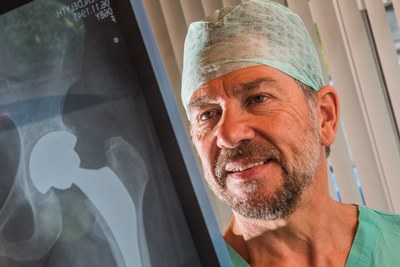
Pioneering hip operations that see patients back on their feet quickly are being taught to medics around the globe by a North Wales surgeon.
Orthopaedic surgeon Jamie Wootton, based at Wrexham’s Spire Yale Hospital, has even created a special operating table with his engineer brother – and the pair have also picked up a top American medical award for their invention.
The so-called Direct Anterior Approach to Hip Surgery gets patients walking unaided just days after their replacement operations, instead of the usual six weeks it takes with traditional techniques – so helping prevent deep vein thrombosis.
The key-hole operation also means there’s only a small scar and less pain as the muscles are not divided and do not need to recover as they do after standard traditional hip replacement, said Mr Wootton.
He now teaches other orthopaedic surgeons around the world how to carry out the operation.
Among those who have benefited from Mr Wootton’s skills is literacy consultant Delyth Owen, who was so impressed with the results of her first hip-op she’s just had her other hip joint replaced. The former teacher said her hip problems were exacerbated as she needed to sit on small, low chairs using in primary schools whilst helping the young children with their writing skills during demonstration lessons.
Mr Wootton explained: “When surgeons employ the anterior approach to hip replacement surgery, they enter the hip through the front part of the joint.
“It’s not the size of incision that matters – it’s what you do inside the body. When we take the anterior approach, we don’t detach or remove any muscles.
“From a recovery standpoint, that means less pain and a quicker return to function. The anterior approach is a minimally invasive surgery because you can perform the whole procedure through a 10cm or less incision. When surgeons eliminate the muscle disruption, they can return to regular activity quicker.”
Mr Wootton also uses X-rays to ensure pinpoint accuracy, that the joints are perfectly aligned and the legs the same length, so preventing patients developing a limp after their operation.
“With this equipment, you are watching the procedure on X-ray as you go in so you can see where the implant is going and get it exactly where you want it,” said Mr Wootton. “This gives you better control of the patient’s leg length.”
Although the technique is now widely used in Australia and parts of Europe, the UK is lagging behind, because surgeons need extra training plus specialised equipment, such as operating tables that allow the legs to be moved around during surgery. Also, the operation does not take any longer than the traditional method.
Mr Wootton added: “I know the implants I use are durable and I can see patients have a good outcome. It’s the next step forward in what we do as far as hip replacement surgery.
“Patients can sleep on their side after the operation – rather than just their back as recommended after traditional surgery and they are only in hospital a few days. Within days they are walking without any aids, whereas recovery after an operation using the traditional techniques can take several weeks.”
He is now treating patients from around the UK at Wrexham’s Spire Yale Hospital, especially senior managers and those who run their own companies, who do not have time to spend months recuperating after an operation.
This month he carried the technique for a second time on Mrs Owen, replacing her left hip joint. She faced having to close down her educational consultancy – for which her husband and two sons Dylan and Marc also work – because of her hip problems. And she feared that recovering from the operations would take weeks or even months.
Instead the ex-teacher from Prestatyn is looking forward to getting back behind the driving wheel so she can continue travelling around the UK with her educational consultancy and social enterprise Treehouse Tales, which takes the National Curriculum into the children’s world of make-believe. Her books and stories capture the children’s imagination and help them to learn, while soft toy characters provide teaching aids.
“I started with pain in my right hip, and it gradually got worse over a year or so, making it painful to drive and to get in or out of the car. I was a very active person, and I did lots of walking, but the pain in my hip meant I couldn’t do that, and I had to give up driving around the country with my work – my husband Trevor, who is also a retired teacher now drives me.
“I stopped sitting down on small chairs with children to help them learn to write from the structured stories I have written, instead I now work with teachers. That means I can sit down or stand as needed, to relieve the pain in my hip.
“My family GP recommended Mr Wootton and I read up about the technique and thought it suited what I needed. Mr Wootton also explained everything very clearly to me – it was only a month from seeing my GP to my first consultation with Mr Wootton.
“After the operation I was up and about quickly and out of hospital after just a few days. I began needing a couple of crutches but within days I didn’t need any walking aids – in fact I was concerned that I had stopped using them too quickly!”
She has now decided to have a similar operation on her left hip, which was also causing her pain, and is looking forward to being able to play with her three-year-old granddaughter Rose.
“Several of my friends have also had hip operations and seemed to take a long time to recover. I can’t understand why more surgeons don’t use this technique, it was so quick and straightforward and has really transformed my life,” added Mrs Owen.